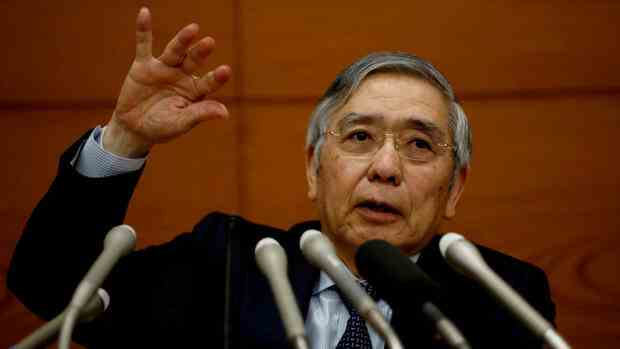The head of the central bank will leave office in the spring of the new year.
(Photo: Reuters)
Tokyo It was only a few days ago that the Bank of Japan (BoJ) caused a stir with a surprising tightening of its monetary policy – at least that’s how many investors interpreted it. Now the central bank around its boss Haruhiko Kuroda is trying to reclassify the steps.
At an event on Monday, Kuroda clarified that with regard to loose monetary policy, the recent change in yield curve control was “definitely not a step towards an exit” from loose monetary policy. Rather, the change should contribute to a functioning bond market, said Kuroda.
The stock market took the comments positively. Japan’s Nikkei index rose 0.65 percent on Monday. Most international stock exchanges remained closed that day due to the Christmas holiday.
Especially on Friday after the latest inflation figures, some investors had interpreted the situation differently. In Japan, consumer prices have risen at their highest rate in more than 40 years. This development sparked new speculation about the future course of the Japanese central bank.
Top jobs of the day
Find the best jobs now and
be notified by email.
The monetary watchdogs announced last Tuesday that they would adjust the yield curve control program. Specifically, the central bank decided that the yield on ten-year government bonds can fluctuate by 0.50 percentage points around the target value of zero percent instead of the previous 0.25 percentage points. The BoJ also announced that it would increase its monthly government bond purchases.
Signal tightening of monetary policy
The decision of the monetary authorities caught investors completely unprepared and led to losses on the stock exchanges, but also on the bond markets around the world. Investors had expected that the BoJ would make no more changes to its yield curve management until Kuroda’s announced departure in April 2023. They took the steps as a possible signal of an initial tightening of monetary policy.
>> Read here: Japanese core inflation hits highest level since 1981
Until then, the Bank of Japan had always emphasized that it wanted to maintain its strategy of extremely loose monetary policy. In this respect, it differed greatly from other leading central banks around the world.
In November, core inflation in Japan rose by around 3.7 percent compared to the same month last year. The figures had caused stock prices to fall on Friday, because the core inflation rate, which does not include the volatile prices for fresh food, has risen at its fastest rate since 1981. In October, inflation had climbed by 3.6 percent.
Inflation in Japan is well below the inflation rates in Germany or the United States. However, the price increase has clearly exceeded the central bank’s stability target for months.
Similar to the US Federal Reserve or the European Central Bank, the BoJ is aiming for an inflation rate of around two percent. Japan has had to struggle with deflationary phases time and again in recent years, and consumer prices have fallen as a result.
More: 20 strategists reveal what they expect for the Dax in 2023
